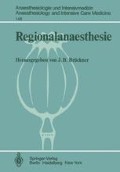Zusammenfassung
Carticain 2% ist um 1 mg pro ml schwerer als Liquor [1]. In einem Modell des spinalen Subarachnoidalraums verhielt sich dieses Lokalanaesthetikum jedoch nahezu isobar [3]. Wir verwendeten diese Substanz zur isobaren Spinalanaesthesie und stellten folgende Fragen zur sensiblen und motorischen Blockade:
Wie zuverlässig ist die kraniale Ausbreitung steuerbar? Welche Latenz- und Regressionszeiten ergeben sich? Wie wirkt sich unterschiedliche Konzentration bei konstantem Injektionsvolumen aus?
Access this chapter
Tax calculation will be finalised at checkout
Purchases are for personal use only
Preview
Unable to display preview. Download preview PDF.
Literatur
Becker J, Theiß D, Lanz E, Erdmann K (1979) Dichte von Liquor und Lokalanaesthetika. Regional-Anaesthesie 2:81–82
Gray DC, Carel WD, Smith BCh and TC (1980) Effects of density of Solution on extent of subrarachnoidal block. Anesthesiology 53:234
Lanz E, Theiß D, Erdmann K, Becker J (1980) Modelluntersuchungen zur Ausbreitung der „isobaren“ Spinalanaesthesie. Regional-Anaesthesie 3:4–9
Levin E, Muravchick S, Gold MI (198) Comparison of isobaric and hyperbaric tetracaine spinal anesthesia. Anesthesiology 53:221
Nolte H, Stark P (1979) Die Dosis-Wirkungsrelation des isobaren Bupivacain zur Spinalanaesthesie. Regional-Anaesthesie 2:1–4
Schellenberg B (1980) Isobare Spinalanaesthesie mit Lidocain, Mepivacain, Bupivacain und Tetracain — Klinische Untersuchung zur sensiblen und motorischen Blockade. Diss Mainz
Editor information
Editors and Affiliations
Rights and permissions
Copyright information
© 1982 Springer-Verlag Berlin Heidelberg
About this paper
Cite this paper
Theiß, D., Wode, M. (1982). Carticain zur isobaren Spinalanaesthesie. In: Brückner, J.B. (eds) Regionalanaesthesie. Anaesthesiologie und Intensivmedizin / Anaesthesiology and Intensive Care Medicine, vol 148. Springer, Berlin, Heidelberg. https://doi.org/10.1007/978-3-642-68705-1_10
Download citation
DOI: https://doi.org/10.1007/978-3-642-68705-1_10
Publisher Name: Springer, Berlin, Heidelberg
Print ISBN: 978-3-540-11744-5
Online ISBN: 978-3-642-68705-1
eBook Packages: Springer Book Archive

